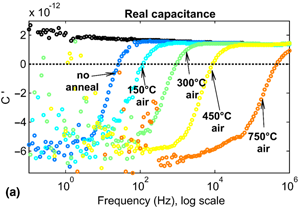Article contents
Detection of plasmonic behavior in colloidal indium tin oxide films by impedance spectroscopy
Published online by Cambridge University Press: 06 April 2020
Abstract

Impedance spectroscopy was conducted on colloidal ITO thin films that had been subjected to alternating oxygen and argon plasma treatments, followed by air annealing from 150 to 750 °C. An equivalent circuit consisting of an RC element nested within another RC element, featuring a negative resistance and a negative capacitance, fitted the data well. These results are interpreted as being due to surface plasmons that are a function of the presence of nanoporous ITO-rich regions surrounded by isolated ITO nanoparticles coated with an amorphous polymer that intertwines with the ITO-rich regions as a function of annealing treatment.
- Type
- Research Letters
- Information
- Copyright
- Copyright © Materials Research Society 2020
References
- 3
- Cited by




